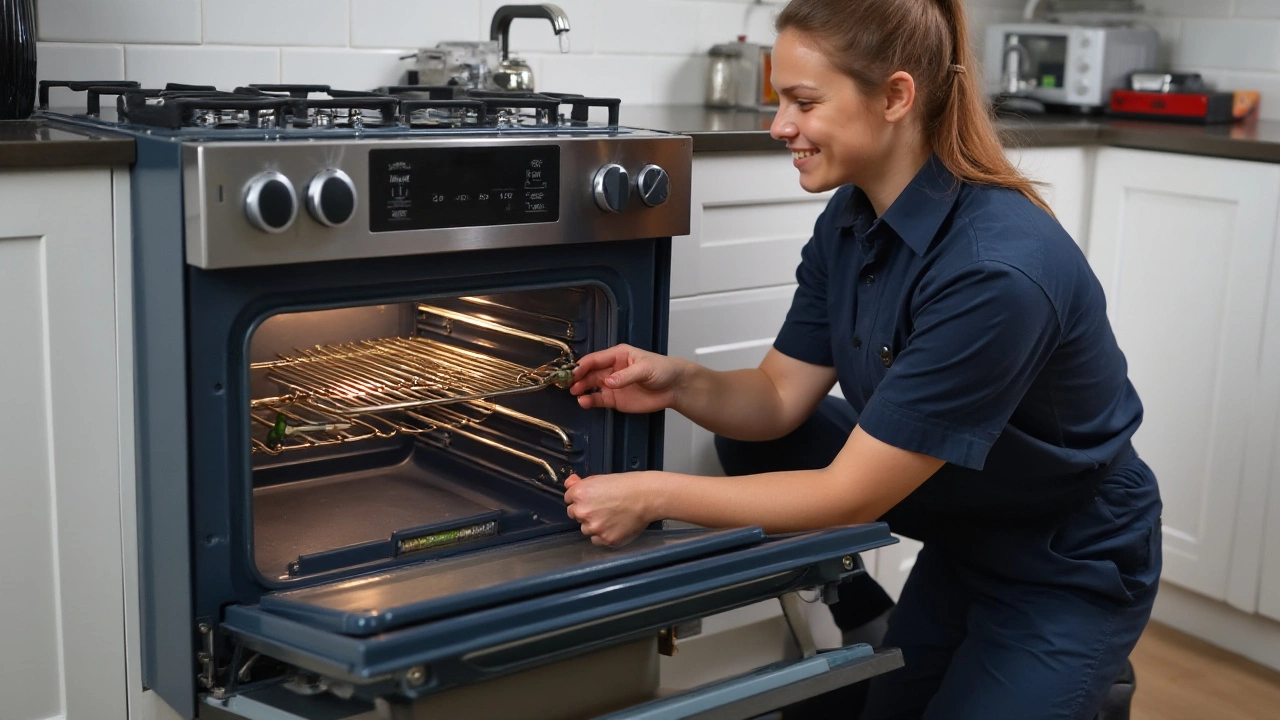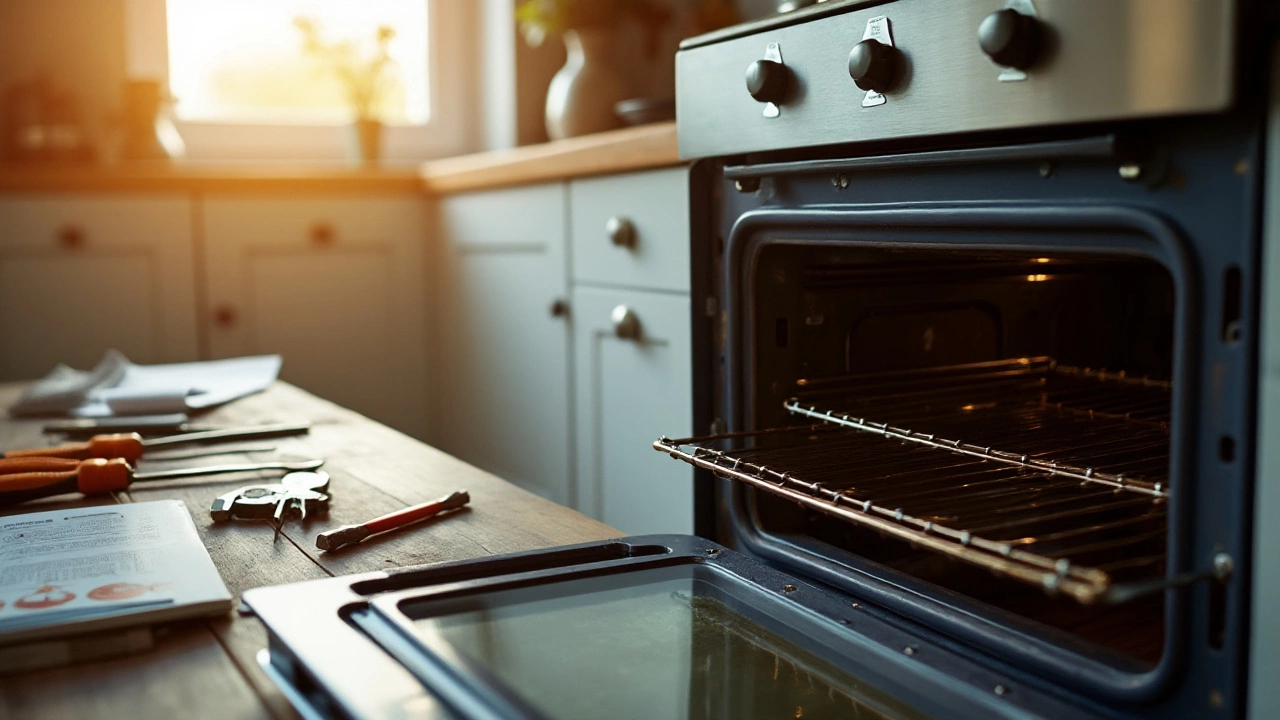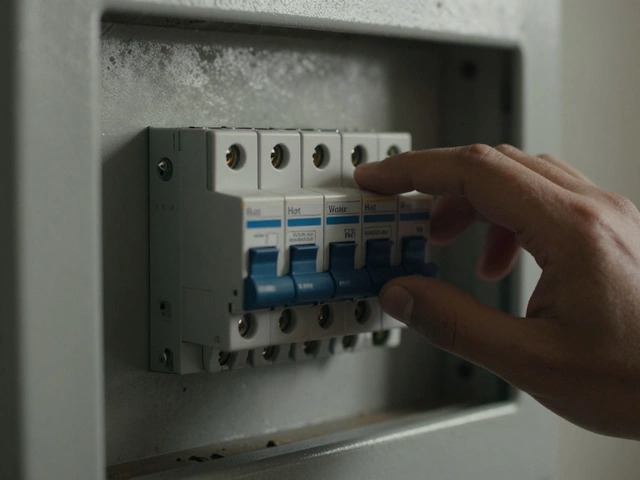A cold oven is the last thing you need at dinnertime. When your electric oven refuses to heat up properly, a faulty heating element could be the culprit. Knowing how much it costs to replace this crucial component is vital for planning your repair strategy.
Before diving into repair costs, it's essential to recognize the signs of a failing heating element. Common indicators include uneven cooking, no heat when broiling, or a complete lack of heat, despite the oven being on. Once you're sure the element is at fault, it's time to consider your repair options.
The cost of replacing a heating element in an oven varies. It depends on factors like the model of the oven, the price of the replacement part, and whether you opt for a DIY approach or hire professional help. Understanding these factors can guide you in making an informed decision.
In this article, let's delve into the specifics of diagnosing and tackling heating element issues. You'll also find tips for everyday maintenance to keep your oven running smoothly, ensuring your home-cooked meals cook to perfection every time.
- Signs of a Faulty Heating Element
- Cost of Replacement Parts
- DIY vs Professional Repair
- Frequently Asked Questions
- Tips for Oven Maintenance
Signs of a Faulty Heating Element
The heating element in your electric oven is the unsung hero of countless dishes, but it rarely gets the attention it deserves—until it stops working. Identifying signs of a failing heating element can save you the hassle of ruined meals and unexpected delays. One of the first things you might notice is that the oven isn't heating evenly. Your pie may come out half-baked on one side while perfectly golden on the other. This often happens because one part of the heating element has broken or is no longer evenly distributing heat.
An oven that refuses to heat up at all is another telltale sign. If you preheat your oven and find that it's stone-cold moments later, there's a strong possibility the heating element has given up the ghost. On the other hand, if it’s not achieving full temperature despite the thermostat reading otherwise, then there’s likely an issue.
Another symptom could be longer cooking times. Sometimes the heating element may start to wear down without completely failing. You pop in a tray of cookies and find they aren't ready until five minutes past the expected time. This creeping inefficiency is a classic signal that a replacement is on the horizon. As for the broil function, if it works like a sauna on vacation, only getting hot enough for a leisurely steam, that's yet another indicator. Should the broiler not work, it could be the upper heating element that's the problem.
Additionally, visible damage is an obvious sign—literally. A glance into your oven cavity can tell you a lot. If you notice that the element is cracked, blistered, or has visible wear and tear, it's time for action. Pay attention to unusual sparking or flare-ups inside the oven, too. These are not just signals of a bad day—but of a bad element.
According to Richard S. from 'Appliance Repair Pros', "A faulty heating element not only affects the cooking quality but can be a safety hazard if left unaddressed."
Regularly inspecting the element can preempt these larger issues. Keep an eye out for any discoloration, as well. If any part of the heating element appears burnt or unusually colored compared to the rest, the balance could be disrupted, leading to poor performance. Trust your instincts: if something seems off, it probably is. Identifying these signs promptly can guide you to necessary repairs, saving your cherished meals and perhaps, preventing oven replacement in the long run. And remember, sometimes a simple reset—turning off and on, can address minor irregularities, but major faults usually require replacement. When cooking times start to feel like forever, a new heating element can make all the difference.
Cost of Replacement Parts
When it comes to replacing the heating element in your electric oven, the cost of the parts can vary considerably. This variance largely depends on factors such as the brand and model of your oven, as well as the availability of compatible parts. Leading brands like Whirlpool, GE, and Samsung often have higher-priced elements, given their reliance on proprietary designs and technology. On average, you might expect to pay anywhere from $20 to $100 for the element itself, with specialty or high-end models creeping towards the pricier end of the spectrum.
It's worth noting that a high price doesn't necessarily equate to better quality or performance. It often correlates more closely with the brand recognition and specialty nature of the oven in question. Therefore, when sourcing replacement parts, it's wise to compare prices from different suppliers, including online retailers and local appliance stores. Websites like Amazon and appliance-specific platforms offer a wide array of options, often at competitive prices that can undercut traditional retail outlets. This is especially true for older models, where specific parts may be harder to come by.
In certain situations, OEM (Original Equipment Manufacturer) parts can be beneficial. Although these might come with a higher price tag, they guarantee compatibility and long-term function. However, third-party manufacturers often deliver equally reliable and more budget-friendly alternatives. The latter can be particularly attractive options for those looking to balance performance and expenditure. One should always ensure these parts meet quality standards by checking customer reviews and supplier reputations before purchasing.
Once you've identified the right part for your oven, the next step is to consider whether to proceed with a DIY repair or hire a professional. A DIY approach can save on labor costs but bear in mind the importance of safety and the potential complexity of the job. There's also the potential risk of voiding any existing warranty on your oven, which could result in higher costs down the line. A pro tip here is to always check the oven's warranty and service agreements before deciding on a course of action.
Jeff Stevenson, a technician with 20 years of experience in appliance repair, states, "Investing in a quality replacement part is crucial. A cheap element might be tempting but can lead to further damage and end up costing more in the long run."
To give you an overview of the cost impact, the following table illustrates a breakdown of average part prices by brand and category:
| Brand | Average Cost (USD) |
|---|---|
| Whirlpool | 50-90 |
| GE | 35-75 |
| Samsung | 40-85 |
| Frigidaire | 25-65 |
| LG | 20-60 |
Deciding on the right part involves more than just the initial price tag. It requires an understanding of your oven's specifications and desired outcomes. With the right approach, you can ensure that your oven continues to deliver reliable performance without breaking the bank. Always consider these cost factors in context with your specific needs, prioritizing both safety and efficiency in your decision-making process.

DIY vs Professional Repair
When the comfortable warmth of a well-functioning oven fails to materialize, you're left with the vexing question: should you attempt a do-it-yourself solution or leave this task to the professionals? Replacing a heating element in an electric oven doesn't have to be as intimidating as it might first seem. With the right tools, a bit of know-how, and a dash of patience, you can potentially save a significant amount by opting for a DIY approach.
To start, consider your own abilities and comfort levels regarding appliance repairs. If you have successfully tackled minor household repairs in the past, managing this task might be well within your skill set. You'll need to disconnect the oven from the power source—a critical safety measure—and remove the back panel to access the faulty element. Having a multimeter handy can help to confirm that the issue lies with the heating element itself. Replacing it involves unscrewing the damaged element and fitting in a new one, which typically involves a series of straightforward steps.
On the flip side, the allure of professional repair offers a peace of mind that comes with expertise and experience. Hiring an expert means you won't have to worry about inadvertently causing additional damage to your appliance. Moreover, professional service often includes a warranty for the repair, providing a safety net should the problem reoccur. You'll also save yourself the time and potential frustration that can accompany DIY endeavors, as many of us have experienced at one time or another.
There's a margin for mistakes with the DIY method—such as improperly reattaching wires or choosing the wrong replacement part. Additionally, it’s worth noting that even though the initial cost of a heating element may be low, expenses can add up if multiple elements are found defective or if errors cause further damage that requires professional attention later. In contrast, expert repair services tend to carry a higher upfront cost but are often more reliable in the long term.
According to a survey by HomeAdvisor, “The typical range for hiring a professional to replace a heating element in an oven can be anywhere between $150 and $400, depending on complexity and location.”
Ultimately, the decision between DIY and professional repair hinges on a balance of your confidence, available time, and budget. Whether you choose to roll up your sleeves and get to work or call in an expert, both options have their merits. You simply need to weigh them based on your personal circumstances. When considering the cost of oven repair, keeping the long-term functionality and safety of your appliance at the forefront of your decision will invariably lead you to the best choice for your specific situation.
Frequently Asked Questions
When it comes to replacing a heating element in your electric oven, doubts and questions are natural. Here we address some of the most commonly asked questions to help you on your repair journey. With this wisdom, stepping into the world of oven repair becomes less daunting and more empowering.
1. How can I tell if my oven's heating element is broken?
A reliable oven is crucial for preparing delightful meals, but identifying a faulty element before delving into heating element replacement is key. Some signs are quite blatant—like the oven's reluctance to heat or uneven cooking. But you might notice subtler signs, such as inconsistent temperatures or a non-responsive broil setting. To confirm suspicions, inspect the element closely. A thorough examination often reveals visible damage, like blistering or breakage. It's also helpful to listen for unusual sounds like buzzing or clicking, which could signal a malfunction.
2. What factors influence the cost of replacing a heating element in an electric oven?
The cost of replacing a heating element depends on several factors. Primarily, the electric oven model can significantly impact the price. Some high-end models may require proprietary parts, which tend to be pricier. Labor charges, if you choose to seek professional help, will also add to the expense. However, a do-it-yourself effort usually saves money but requires time and some level of technical comfort. On average, prices for the element itself range from $20 to $40, but hiring a professional can bring the total anywhere from $100 to $300.
3. Is it better to replace the heating element myself or hire a professional?
Deciding between a DIY repair or engaging a professional for appliance repair involves weighing various considerations. If you're handy with tools and comfortable working with electrical components, DIY can be quite rewarding and conserve finances. However, safety is paramount. If there's any doubt about handling electricity or removing and installing the part, hiring a pro is wiser. Professionals bring experience and expertise, minimizing the risk of further damage. They also provide warranties for their work, offering peace of mind and assurance of a job well done.
"Electrical elements may seem straightforward, but small errors can lead to big problems. When uncertain, opting for professional repair is always prudent," advises Dana Reilly, an experienced appliance technician.
4. How can I prolong the life of my oven's heating element?
Maintaining your oven effectively prolongs the life of its components, such as the heating element. One fundamental tip is regular cleaning. Grease and grime can impede heat distribution, leading to overworking the element. Avoid using harsh cleaners that cause damage to the element surface. Instead, use mild, specially formulated cleaning agents. Additionally, ensure your oven runs at optimal temperatures by avoiding extreme high-heat settings unless necessary. Regular checks for damage instill good habits; any small issues can be addressed before escalating into significant repairs. These simple steps help your oven's heart, the heating element, beat steadily for years to come.
5. Are there any statistics or data to support the prevalence of heating element replacement?
Interestingly, heating element issues rank high on the list of oven repair concerns. According to data from the Appliance Repair Statistics Handbook, nearly 25% of all oven repairs involve some component of heating elements. This prevalence highlights the importance of understanding the intricacies of heating element replacement. Regular maintenance and prompt attention to odd behaviors significantly decrease these statistics, as attentive care often equates to fewer breakdowns. An informed approach saves not only on potential repair costs but also on the inconvenience of interrupted meal preparations.

Tips for Oven Maintenance
Maintaining your electric oven in optimal condition is crucial for ensuring it performs efficiently and lasts longer. One of the foundational tips for oven care is regular cleaning. Residual grease and food particles are notorious for sparking fires and causing unpleasant odors. To clean your oven, first remove the racks and, using a mixture of baking soda and vinegar, gently scrub the interior. This homemade solution is both effective and safe, avoiding the harsh chemicals in commercial cleaners. For best results, aim to clean your oven every three months or more often if you bake frequently.
Another vital maintenance task involves inspecting the oven door's seal. A worn or damaged seal allows heat to escape, making your oven work harder and increasing electricity costs. To check the seal, open the oven door and feel around its edges. If you detect any inconsistencies, it may be time for a replacement. Replacing a defective seal can improve the overall energy efficiency by up to 20%, a significant saving for any household.
For those who often use the broiling functions of their oven, periodic inspection of the heating elements is essential. Elements can wear out due to frequent thermal expansion and contraction. Look for any visible signs of wear such as blisters or breaks. If notice a fault, consider replacing the element as soon as possible to maintain cooking performance. "Routine maintenance of appliances not only extends their life expectancy but also conserves energy," says John Simmons, an appliance repair specialist from Home Essentials.
It's easy to overlook the importance of cleaning behind and around the oven, but dust and food debris can accumulate in these hard-to-reach areas, potentially leading to inefficiencies and even hazards. Make it a habit every six months to gently pull the oven away from the wall and vacuum or sweep thoroughly. Make sure to unplug the appliance first to avoid any accidents.
Lastly, a less-known but important task is to occasionally check the level of your oven. An unlevel oven can affect cooking times and results because heat may not distribute evenly. Use a simple spirit level and adjust the feet of your oven until it is perfectly straight. Reliable cooking performance not only relies on the condition of heating elements but also on such overlooked mechanical aspects.
Turn habits into routine checks and your oven will thank you by consistently delivering delicious meals. Whether you're replacing your heating elements or just giving your oven a much-needed clean-up, these maintenance tasks go a long way in keeping your electric oven functioning smoothly for years to come.





